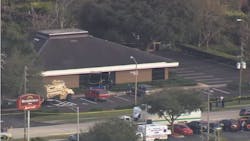The recent shooting at the SunTrust Bank branch in Sebring, Fla., was not the first financial institution to experience an active shooter in the last five months. Banks and credit unions may be increasingly at risk from both random attacks, based on incidents in 2018.
Sebring is a small town of approximately 11,000 residents, located 86 miles east of Port St. Lucie and Vero Beach, Florida. On Jan. 25, a 21-year old walked into the SunTrust Bank with a handgun he purchased just days before the incident and shot and killed five women including four staff members, and one customer. One staff member escaped by running away.
Banks Have Not Been Targets Until Now
The attack was reminiscent of a shooting in downtown Cincinnati at Fifth Third Bank headquarters on Sept. 6, 2018, where 29-year-old Omar Perez came in through the loading dock, with a 9 mm semi-automatic pistol, multiple magazines and more than 200 rounds of ammunition. He was shot and killed by police after shooting five people, three of whom died from their injuries. The shooting in Sebring was different, because the shooter, Zephen A. Xaver, had women lay face down on the floor before he shot them each in the back of the head, killing each of them execution style, according to an affidavit released on Friday by the Highland County Sheriff's Office.
Xaver called 911 himself and told the dispatcher that “five people had been shot.” There was no known motive and he did not know any of the victims.
He barricaded himself in the bank, while police unsuccessfully attempted to negotiate with the suspect. As a SWAT team broke through the lobby doors, entered the bank and continued negotiations, officers found the shooter hiding in a back office. He eventually surrendered to police, according to Sebring Police Chief Karl Hoglund.
Shooter Had a Troubled Past
According to others who knew the shooter, he often complained about being bullied at school and disliked by his family. When Xaver got upset, the friend said, he openly talked about a desire to hurt people and how he had access to guns and was obsessed with violence and killing. Although the shooter was currently living in Sebring, he had spent most of his life in a small Indiana town south of South Bend. He had recently trained to be a correctional officer at the Avon Park Correctional Institution, a prison about 20 miles north of Sebring, according to Patrick Manderfield, a spokesman for the Florida Dept. of Corrections.
The Bremen Police Department in Indiana released documents to CNN that detailed previous encounters with Xaver in Indiana. As a 16-year-old student at Bremen High School, Xaver was taken to a behavioral health center in February 2014 after he told a school counselor "he had a dream last night of killing students in a classroom," according to a police report.
In March 2017, Michigan State Police had contacted the Bremen Police Department to report that a female student was getting messages from Xaver saying he was "possibly thinking of suicide by cop" and "taking hostages," the police report said. Officers contacted his mother, who declined police assistance and said she would speak with him, it said.
The Sebring shooter was the seventh active shooting in Florida in the past three years, including the infamous Pulse nightclub shooting, the Parkland shooting, and the Jacksonville Landing shooting. In an analysis by the Gun Violence Institute, the states with the highest rate of Active Shooting incidents are California, Florida and Illinois.
No Access Control
The graph below summarizes of some of the highest profile active shootings in 2018. The most telling column of the graph shows that 99 percent of the incidents took place in facilities that had no access control.
How to Prevent or Reduce Active Shooter Incidents
Prevention of active shooter and mass casualty events is possible, but organizations have to invest in the controls that will keep their staff, and their customers, patients, students, visitors and others safe from an incident.
The OSHA General Duty clause requires employers to furnish a workplace free of recognized hazards. Now that active shooting incident has become so widespread in hospitals and healthcare facilities, working environments for healthcare workers are nine-times more dangerous than working outside on a high rise building.
The costs of many of the most effective security controls have come down significantly in the last five years, as competition from online retailers and Amazon have caused prices to fall. Personal panic alarms for receptionists can be acquired for $15.00 per employee so the argument that “we can’t afford security,” is no longer true.
With prevention in mind, here is a list of suggested controls that organizations can use to reduce the likelihood of an active shooter incident in their facility.
- Access control with key card systems, or cipher-locks (push code).
- Panic alarms for receptionists and for those in public-facing locations.
- Video surveillance cameras with active monitoring.
- Ensure all doors and perimeter gates are kept locked.
- Perform a proper security risk assessment at the facility.
- Establish a formal security awareness program for staff members.
- Provide policies and procedures for all employees instructing them what to do in a time of crisis and emergencies.
- Install an effective visitor management system.
- Require active shooter training for every employee, every year.
Active shooter incidents are an expensive and damaging occurrence for the organizations that have experienced them. For example, in the Sebring Bank shooting, SunTrust has stated that it plans to close that facility.
Security professionals must focus on preventing future incidents and know that your efforts will not only create a better working environment, but you will gain the gratitude of your staff members. When we interview individuals for active shooter assessments, we find that employees are acutely aware of the potential dangers of an active-shooter event. However, many are extremely worried about their safety and that there have not been adequate protective controls put in place by their employers.
About the Author:
Caroline Ramsey-Hamilton is an expert in Security Risk Assessments and Active Shooter Assessment. She is Certified in Homeland Security (CHS-III), Anti-Terrorism (ATAB) and has received the Lifetime Achievement Award from the Maritime Security Institute. She is currently working with the Palm Beach Police Chiefs Public-Private Partnership to develop prevention programs for organizations across the United States. She has done Assessments on hundreds of hospitals, schools, universities, banks, credit unions, and business facilities, as well as working with and developing risk model assessment for federal agencies, and county the state government agencies. Reach out to [email protected].


